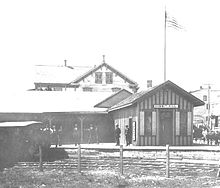
This is a list of the earliest railroads in North America, including various railroad-like precursors to the general modern form of a company or government agency operating locomotive-drawn trains on metal tracks.
Railroad-like entities (1700s–1810s)
- 1720: A railroad was reportedly used in the construction of the French fortress in Louisbourg, Nova Scotia, Canada.
- 1764: Between 1762 and 1764, at the close of the French and Indian War, a gravity railroad (mechanized tramway) (Montresor's Tramway) was built by British military engineers up the steep riverside terrain near the Niagara River waterfall's escarpment at the Niagara Portage, which the local Senecas called Crawl on All Fours, in Lewiston, New York. Before the British conquest, under French control the portage had employed nearly 200 Seneca porters. However, once the British took control of the area, they installed a cable railway using sledges (heavy sleds without wheels) to hold the track between the rails. The sleds were capable of carrying 12 to 14 barrels at a time (a serious weight capacity even if only small shoulder-hoistable/mule-compatible keg-sized barrels, taken along with its longevity) indicating that it was a funicular design with two tracks. With barrels as the primary Up load's configuration and they also provided a ready-made counterweight with addition of sufficient Niagara River water as the likely mass used to adjust the lifting force. Designed by Captain John Montresor, the new railway replaced manual labor performed by the Seneca and touched off what might be the first labor rebellion in North America when the Seneca became unemployed; in September 1763, the Senecas revolted and killed many British soldiers and workers in what is called the Devil's Hole Massacre. The tramway was in use until the early 1800s
- 1799–1805: Boston developers began to reduce the height of Mount Vernon before building streets and homes. Silas Whitney constructed a gravity railroad to move excavated material down the hill to fill marshy areas to create new land from the Back Bay. Frederick C. Gamst, a professor of anthropology at the University of Massachusetts, believed this to be the same railroad equipment as used by Bulfinch on his Beacon Hill railway, given the relations of both men to the land speculation syndicate.
- 1809: A three-quarter-mile wooden tracked railway is built in Nether Providence Township, Pennsylvania by Thomas Leiper to deliver stone from his quarries to market. The track, with a 4-foot (1.2 m) gauge, had a grade of 1½ inches to the yard (1:24 or about 4%) over its total length of 60 yards (54.9 m) and proves satisfactory when tested with a loaded car.
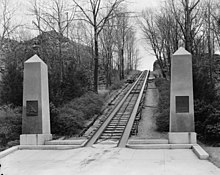
- 1810: The animal-powered Leiper Railroad followed after the preceding successful experiment – designed and built by merchant Thomas Leiper, the railway connects Crum Creek to Ridley Creek, in Delaware County, Pennsylvania. It was used until 1829, when it was temporarily replaced by the Leiper Canal, then is reopened to replace the canal in 1852. This became the Crum Creek Branch of the Baltimore and Philadelphia Railroad (part of the Baltimore and Ohio Railroad) in 1887. This is the first railroad meant to be permanent, and the first to evolve into trackage of a common carrier after an intervening closure.See the 1826 Granite Railway (pictured) for comparison.
- 1811: George Magers designed and built a one-mile (1.6 km) wooden gravity railroad between a gunpowder mill and its powder storage bunker at Falling's Creek, Virginia.
- 1815: New Jersey granted a charter on February 6, 1815, for a company to "erect a rail-road from the river Delaware near Trenton, to the river Raritan, at or near New Brunswick"—that is, to connect the water ports so boats could ferry riders the last distance connecting Philadelphia & Trenton to (19th-century) New York City and Brooklyn & Queens on Long Island via New York Harbor, as proposed by inventor and railway builder John Stevens (1749–1838). This New Jersey Railroad Company was the first passenger carrier railroad chartered in the United States, but failed to attract investors and was never built. Its rights would be passed to the Camden and Amboy Railroad (below), chartered in 1830 and also having Stevens as president.
- 1816: A railroad was reportedly used at Kiskiminetas Creek, Pennsylvania.
- 1818: An iron-smelting furnace at Bear Creek, Armstrong County, Pennsylvania, reportedly had a wooden railroad in operation.
Early railroad companies (1820s–1830s)
- Granite, coal and cotton railroads
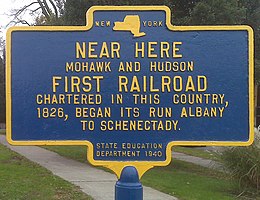
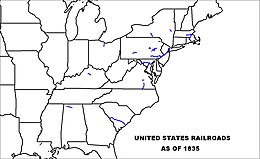
- 1826: The Granite Railway in Massachusetts was incorporated by Thomas Handasyd Perkins and Gridley Bryant. Construction began on April 1, and operations began on October 7. It later became a branch of the Old Colony and Newport Railway, which was later absorbed into the New York, New Haven and Hartford Railroad. This is often called the first commercial railroad in the U.S., as it was the first to evolve into a common carrier without an intervening closure. See the 1810 Leiper Railroad for comparison.
- 1826: On April 9, the Mohawk and Hudson Railroad was incorporated as the first railroad chartered in New York State (marker pictured), and the first railroad in the United States designed to be powered by a locomotive engine as opposed to horse-drawn or gravity railroads. It opened on August 9, 1831, using steam locomotive DeWitt Clinton.
- 1827: The Summit Hill and Mauch Chunk Railroad, often just called The Switchback or the Mauch Chunk Switchback Railroad, Pennsylvania's first railroad and first anthracite carrier initially a 9-mile (14 km) gravity railroad with animal powered return of cars, is built between Summit Hill and Mauch Chunk (now Jim Thorpe), Pennsylvania when rails are laid on top of the existing mule-haul road graded to be nearly uniform in grade from its establishment in 1819–20. Designed by founder Josiah White to drop evenly over its length and superintended in both evolutions by founder Erskine Hazard of the Lehigh Coal & Navigation Company, the railway—as the world's first roller coaster, also became a famous tourist attraction—as were leisure cruises on the company's Lehigh Canal. The road carried cargo as a common carrier back up to Summit Hill almost from the start, but by 1829 the new railed road was carrying passengers flocking out from Philadelphia to enjoy its attractions. It was built to haul anthracite coal from the mines to the Lehigh Canal on the Lehigh River and was the first railroad of this type.
- 1829: On August 8, the Delaware and Hudson Canal Company's gravity railroad in northeast Pennsylvania opened using Stourbridge Lion, the first locomotive to run on rails in the United States. It was also a coal railroad. The canal company, chartered in 1823, called itself "America's oldest continually operated transportation company".
- 1829: The South Carolina Canal and Rail Road Company was chartered December 19, 1827 and was also known as the Charleston & Hamburg Road. An experimental track was installed in February, 1829 to haul bales of cotton in downtown Charleston, South Carolina. On April 1, 1830, a double-tracked 3,800-foot (1,200 m)-long railroad was in full operation. By 1833, this railroad had been completed to Hamburg, South Carolina for a total length of 137 miles (220 km). At that time, it was the longest railroad in the world. This was the first railroad to use steam locomotives regularly. It later became part of the Southern Railway, now part of Norfolk Southern.
- 1829: The Mill Creek & Mine Hill Navigation & Railroad Company was chartered on February 7, 1828. The 4.09-mile (6.58 km) main line from Palo Alto, Pennsylvania to Wolf Creek was completed in 1829 with branches added in 1829 and 1830 for a total of 8.29 miles (13.34 km). It was another coal hauling railroad.
- 1830: The Schuylkill Valley Railroad & Navigation Company was chartered on April 14, 1828. It ran 9.23 miles (14.85 km) from Port Carbon, Pennsylvania to Tuscarora and was completed in 1830. It was built to carry coal from mines to Port Carbon.
- 1830: The Union Canal Company Railroad was a 3.5-mile (5.6 km) railroad constructed by the Union Canal (Pennsylvania) Company and was chartered on March 3, 1826. The company was in the canal business, but due to the topography, it could not extend its canal to the coal fields north of Pine Grove, Pennsylvania. Its solution was to build this short coal-hauling railroad, which was completed in 1830.
- 1830: The Little Schuylkill Navigation, Railroad and Coal Company was chartered on February 28, 1826. The LSRR operated between Tamaqua, Pennsylvania and Port Clinton beginning in 1831 using horse-drawn cars. Two steam locomotives were acquired by the railroad in 1833, but the wooden tracks did not support the engines. Iron "T" rails replaced the wooden ones in 1845, and the locomotives were then returned to regular service. It completed a junction with the Catawissa Railroad at Tamanend, also called Little Schuylkill Junction, in 1854. In 1857, the LSRR built a roundhouse in Tamaqua, housing 21 locomotives and a turntable. In 1863 the company was leased by the Reading Railroad for 93 years. It formally merged with the Reading in 1952. *1830: The Tuscumbia Railway was chartered on January 16, 1830, and proceeded to build a 2.1-mile (3.4 km) railroad from downtown Tuscumbia, Alabama to the docks on the Tennessee River west of Sheffield. This was the first railroad chartered/constructed west of the Appalachian Mountains. In 1832, this railroad was renamed the Tuscumbia, Courtland and Decatur Railroad, and was extended 41.9 miles (67.4 km) to connect the two Alabama cities of Tuscumbia and Decatur.
- 1831: The Mount Carbon Railroad was completed in 1831 running from Mount Carbon, Pennsylvania through Pottsville where it split into two branches, one going to what is now Seltzer and the other to the current Wadesville. This was a coal-hauling railroad, 6.26 miles (10.07 km) in length.
- 1831: The Mine Hill and Schuylkill Haven Railroad completed the first part of its railroad from Schuylkill Haven, Pennsylvania to Minersville with a branch line up the West Branch of the Schuylkill River, a distance of 13.5 miles (21.7 km).
- 1831: The Room Run Railroad was completed along the path of an unsuccessful gravity road, running a distance 5.26 miles (8.47 km) from Nesquehoning to the Lehigh Canal loading docks at Mauch Chunk, Pennsylvania.
- 1831: The Chesterfield Railroad (sometimes called the Manchester Railroad) began operations by September 1831 in Chesterfield County, Virginia.
- 1836 - Lake Wimico and St. Joseph Canal and Railroad Company - was the first railroad to enter into actual operation in Florida.
- 1837 - Tallahassee - St. Marks Rail Road - was the first railroad "Chartered" in Florida (in 1831), but was the second to be completed and begin cargo-hauling operations.
- 1839: Albion Railway serving coal mines around Stellarton, Nova Scotia, first railway in Canada to use iron rails and run year-round; home of Samson, the oldest surviving locomotive in Canada.
Early common carriers (1820s–1830s)
While private railroads are legally free to choose their jobs and customers, common carriers must charge fair rates to all comers.
Any effort to arrange early common-carrier railroads in chronological order must choose among various possible criterion dates, including applying for a state charter, receiving a charter, forming a company to build a railroad, beginning construction, opening operations, and so forth.
| Name | Chartered | State | Opened | Notes |
|---|---|---|---|---|
| Union Canal Company of Pennsylvania | March 3, 1826 | Pennsylvania | 1830 | Chartered on May 30, 1811, to build a canal; authorized to build a railroad on March 3, 1826 |
| Granite Railway | March 4, 1826 | Massachusetts | October 7, 1826 | Only authorized to carry freight until April 16, 1846 |
| Delaware and Hudson Canal Company | April 5, 1826 | Pennsylvania | October 9, 1829 | Chartered on March 13, 1823, to build a canal; authorized to build a railroad on April 5, 1826 |
| Danville and Pottsville Railroad | April 8, 1826 | Pennsylvania | September 24, 1834 | |
| Mohawk and Hudson Railroad | April 17, 1826 | New York | September 24, 1831 | Carried only passengers for first few years of operation due to competition from the adjacent Erie Canal. |
| Baltimore and Ohio Railroad | February 28, 1827 | Maryland | January 7, 1830 | First common carrier in the United States, chartered from its inception to haul freight and passengers on timetabled trains over vast distances with steam power, first to open for public service |
| South Carolina Canal and Railroad Company | December 19, 1827 | South Carolina | December 1830 | Operated first steam hauled passenger train in the United States on a schedule. Known to the public as the Charleston & Hamburg Railroad. |
| Ithaca and Owego Railroad | January 28, 1828 | New York | April 1, 1834 | |
| Mill Creek and Mine Hill Navigation and Railroad Company | February 7, 1828 | Pennsylvania | November 3, 1829 | |
| Tioga Navigation Company | February 7, 1828 | Pennsylvania | 1839 | Chartered on February 20, 1826, to build a canal or slack-water navigation; authorized to build a railroad on February 7, 1828 |
| Baltimore and Susquehanna Railroad | February 13, 1828 | Maryland | July 4, 1831 | |
| Chesterfield Railroad | February 27, 1828 | Virginia | July 1831 | |
| New Castle and Frenchtown Turnpike and Railroad Company | March 14, 1828 | Maryland | February 28, 1832 | Chartered on January 6, 1810, as the New Castle and Frenchtown Turnpike Company to build a turnpike; renamed and authorized to build a railroad on March 14, 1828 |
| Philadelphia and Columbia Railroad | March 24, 1828 | Pennsylvania | October 18, 1832 | Part of the state-owned Main Line of Public Works |
| Schuylkill Valley Navigation Company | April 14, 1828 | Pennsylvania | 1830 | Chartered on March 20, 1827, to build a canal; authorized to build a railroad on April 14, 1828; renamed Schuylkill Valley Navigation and Railroad Company on January 15, 1829 |
| Schuylkill East Branch Navigation Company | April 14, 1828 | Pennsylvania | November 18, 1831 | Chartered on February 20, 1826, to build a lock navigation; authorized to build a railroad on April 14, 1828; renamed Little Schuylkill Navigation, Railroad and Coal Company on April 23, 1829 |
| Mine Hill and Schuylkill Haven Railroad | April 15, 1829 | Pennsylvania | April 1831 | |
| Northern Liberties and Penn Township Railroad | April 23, 1829 | Pennsylvania | April 1834 | |
| Mount Carbon Railroad | July 15, 1829 | Pennsylvania | 1831 | |
| Tuscumbia Railway | January 15, 1830 | Alabama | June 12, 1832 | |
| Pontchartrain Railroad | January 20, 1830 | Louisiana | April 23, 1831 | |
| Lexington and Ohio Railroad | January 27, 1830 | Kentucky | August 15, 1832 | |
| Camden and Amboy Railroad and Transportation Company | February 4, 1830 | New Jersey | October 1, 1832 | |
| Petersburg Railroad | February 10, 1830 | Virginia | October 1832 | |
| Lykens Valley Railroad and Coal Company | April 7, 1830 | Pennsylvania | April 1834 | |
| Beaver Meadow Railroad and Coal Company | April 7, 1830 | Pennsylvania | November 5, 1836 | |
| Canajoharie and Catskill Railroad | April 19, 1830 | New York | 1839 | |
| Boston and Lowell Railroad | June 5, 1830 | Massachusetts | June 24, 1835 | |
| Petersburg Railroad | January 1, 1831 | North Carolina | 1833 | |
| Paterson and Hudson River Railroad | January 31, 1831 | New Jersey | 1834 | |
| Elizabethtown and Somerville Railroad | February 9, 1831 | New Jersey | August 13, 1836 | |
| Saratoga and Schenectady Railroad | February 16, 1831 | New York | July 12, 1832 | |
| West Chester Railroad | February 18, 1831 | Pennsylvania | October 1, 1832 | |
| West Feliciana Railroad | March 5, 1831 | Louisiana | January 1835 | |
| Philadelphia and Columbia Railroad | March 21, 1831 | Pennsylvania | March 18, 1834 | Part of the state-owned Main Line of Public Works |
| Southwark Railroad | April 2, 1831 | Pennsylvania | 1835 | |
| Cumberland Valley Railroad | April 2, 1831 | Pennsylvania | August 16, 1837 | |
| Philadelphia and Delaware County Railroad | April 2, 1831 | Pennsylvania | January 17, 1838 | Renamed Philadelphia, Wilmington and Baltimore Railroad on March 14, 1836 |
| Philadelphia, Germantown and Norristown Railroad | April 5, 1831 | Pennsylvania | June 6, 1832 | First common carrier in Pennsylvania. Earlier railroads were operated to haul minerals like coal and iron, but later in the decade would become modern common carrier systems hauling passengers and public goods. |
| Winchester and Potomac Railroad | April 8, 1831 | Virginia (now partially West Virginia) | March 1836 | |
| New York and Harlem Railroad | April 25, 1831 | New York | November 26, 1832 | |
| Boston and Providence Railroad | July 22, 1831 | Massachusetts | July 28, 1835 | |
| Boston and Worcester Railroad | June 23, 1831 | Massachusetts | April 16, 1834 | |
| Clinton and Vicksburg Railroad | December 19, 1831 | Mississippi | May 15, 1838 | Reorganized by the Commercial and Railroad Bank of Vicksburg on 25 December 1833. Reorganized on 9 March 1850 as the Vicksburg and Jackson Railroad. Reorganized in January 1857 as the Southern Railroad of Mississippi. Reorganized on 28 January 1867 as the Vicksburg and Meridian Railroad. On 22 October 1885, the five foot gauge of the entire line from Meridian to Vicksburg, 152 miles including sidings, was changed to standard gauge of 4 feet 6 inches in about 16 hours. From 1889 the Meridian-Vicksburg Railway line was known as the Alabama & Vicksburg Railway line of the Queen and Crescent Route. |
| Mad River and Lake Erie Railroad | January 5, 1832 | Ohio | 1838 | |
| Tuscumbia, Courtland and Decatur Railroad | January 13, 1832 | Alabama | August 20, 1833 | |
| Wilmington and Susquehanna Railroad | January 18, 1832 | Delaware | July 14, 1837 | |
| Lawrenceburg and Indianapolis Railroad | February 2, 1832 | Indiana | July 4, 1834 | |
| Ohio and Indianapolis Railroad | February 3, 1832 | Indiana | 1851 | Renamed Jeffersonville Railroad on February 3, 1849 |
| Philadelphia and Trenton Railroad | February 23, 1832 | Pennsylvania | November 14, 1833 | |
| Baltimore and Port Deposit Railroad | March 5, 1832 | Maryland | July 6, 1837 | |
| New Jersey Railroad and Transportation Company | March 7, 1832 | New Jersey | September 15, 1834 | |
| Portsmouth and Roanoke Railroad | March 8, 1832 | Virginia | July 27, 1834 | |
| New Jersey, Hudson and Delaware Railroad | March 8, 1832 | New Jersey | 1872 | Merged into the New Jersey Midland Railway on April 26, 1870 |
| Franklin Railroad | March 12, 1832 | Pennsylvania | September 10, 1839 | |
| Delaware and Maryland Railroad | March 14, 1832 | Maryland | July 14, 1837 | Merged into the Wilmington and Susquehanna Railroad on April 18, 1836 |
| York and Maryland Line Railroad | March 14, 1832 | Pennsylvania | August 23, 1838 | |
| Liggett's Gap Railroad | April 7, 1832 | Pennsylvania | October 20, 1851 | Renamed Lackawanna and Western Railroad on April 14, 1851 |
| Rensselaer and Saratoga Railroad | April 14, 1832 | New York | April 19, 1836 | |
| Saratoga and Fort Edward Railroad | April 17, 1832 | New York | October 15, 1848 | Reorganized as the Saratoga and Washington Railroad on May 2, 1834 |
| New York and Albany Railroad | April 17, 1832 | New York | December 31, 1848 | Sold to the New York and Harlem Railroad on March 9, 1846 |
| Watertown and Rome Railroad | April 17, 1832 | New York | October 1849 | |
| Tonawanda Railroad | April 24, 1832 | New York | May 1837 | |
| New York and Erie Railroad | April 24, 1832 | New York | September 23, 1841 | |
| Brooklyn and Jamaica Railroad | April 25, 1832 | New York | April 18, 1836 | Leased by the Long Island Rail Road from opening |
| Hudson and Berkshire Railroad | April 26, 1832 | New York | September 26, 1838 | |
| Boston, Norwich and New London Railroad | May 1, 1832 | Connecticut | 1840 | Merged into the Norwich and Worcester Railroad on June 22, 1836 |
| New York and Stonington Railroad | May 14, 1832 | Connecticut | November 17, 1837 | Merged into the New York, Providence and Boston Railroad on July 1, 1833 |
| Portsmouth and Lancaster Railroad | June 9, 1832 | Pennsylvania | September 16, 1836 | Renamed Harrisburg, Portsmouth, Mountjoy and Lancaster Railroad on March 11, 1835 |
| Williamsport and Elmira Railroad | June 9, 1832 | Pennsylvania | January 12, 1837 | |
| Strasburg Rail Road | June 9, 1832 | Pennsylvania | 1837 | Still in operation as a shortline freight hauler and tourist railroad. Recognized as the oldest, continuously operating railroad in the United States as it still operates under its original 1832 charter. |
| New York, Providence and Boston Railroad | June 23, 1832 | Rhode Island | November 17, 1837 | |
| Detroit and St. Joseph Railroad | June 29, 1832 | Michigan | February 3, 1838 | Sold to the Central Railroad of Michigan on April 22, 1837 |
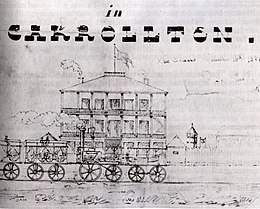
Selected railroads chartered since 1832:
- 1835: The New Orleans and Carrollton Railroad began operation after four years of work; rail route still in operation as the St. Charles Streetcar Line in New Orleans.
- 1836: The Lake Wimico and St. Joseph Canal and Railroad Company was the first steam railroad in Florida, opening on September 5.
- 1836: The Champlain and St. Lawrence Railroad opened in Quebec, Canada.
- 1838: The Northern Cross Railroad opens in Central Illinois; to this day, part of the NCR still operates under the Norfolk Southern Railway.
Tunnels and bridges
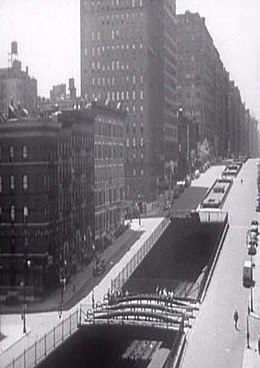
- 1829: Carrollton Viaduct built of stone for Baltimore & Ohio Railroad, 312 ft (95 m) over Gwynns Falls River in Baltimore, Maryland
- 1831 Farnsworth Avenue Stone Arch Carriage Bridge over the Camden & Amboy RR. Bordentown NJ: First bridge completed over Stevens' newly designed rolled iron inverted T-rails made in Wales. Today trains still pass under the arch on new rails of similar design. Roadway is still used above the stone arch. Designed by Wilson. Keystone date 1831. Made of Stockton Sandstone
- 1833 (June): The Staple Bend Tunnel, the first railroad tunnel in the U.S., completed in June 1833 as part of the Allegheny Portage Railroad which opened in March 1834. Trains stopped running through the Staple Bend Tunnel in 1857, and it is now part of the Allegheny Portage Railroad National Historic Site.
- 1833 (December): Wadesville Tunnel, built by Danville and Pottsville Railroad at Wadesville, Pennsylvania.
- 1835: Thomas Viaduct built of stone for Baltimore & Ohio Railroad, 614 ft (187 m) over Patapsco River in Relay, Maryland
- 1835: Canton Viaduct built of stone for Boston & Providence Railroad, 615 ft (187 m), over Canton River in Canton, Massachusetts
- 1837: The Yorkville Tunnel opened on October 26, for the New York and Harlem Railroad. It was absorbed in the 1870s by the longer and wider Park Avenue Tunnel, and is used by all Metro-North Railroad commuter trains. The old tunnel carries the two center tracks, and two new tunnels carry outer tracks.
- 1837: The Taft Tunnel opened in 1837 for Norwich and Worcester Railroad in Lisbon, Connecticut, north of Norwich, Connecticut. This is the oldest tunnel still in use in its original form in the U.S.
- 1837: The Howard Tunnel in York County, Pennsylvania. Considered the second-oldest tunnel still in use in its original form in the U.S.
- 1842: The Potomac Creek Bridge, 400 ft (120 m) long, was built across the Potomac Creek in Stafford County, Virginia.
- 1848: Starrucca Viaduct built of stone for the Erie Railroad 1,040 ft (320 m) over Starrucca Creek in Lanesboro, Pennsylvania
- 1850: The Henryton Tunnel on the Baltimore and Ohio Railroad.
- 1850: The Chetoogeta Mountain Tunnel on the Western and Atlantic Railroad, Tunnel Hill, Georgia. 1,477 feet long and the first major railroad tunnel in the south.
- 1856: The Blue Ridge Tunnel, 4,263 ft (1,299 m), considered a world marvel of engineering when opened.
- 1872: The Hauto Tunnel 3,800 ft (1,200 m) enabled a saving of over 14.5 miles (23.3 km), most (12.5 miles (20.1 km)) with steep grades, of the former Nesquehoning & Mahanoy Railroad for the several millions of tons/annum of anthracite shipped by the Lehigh Coal & Navigation Company from its Lansford and Coaldale breakers in the Panther Creek Valley. The tunnel allowed retirement and conversion of the famous Switchback Railroad (the Summit Hill & Mauch Chunk Railroad) into a tourism-only railroad owned by the Mauch Chunk, Summit Hill Switch-Back Railway Company
West of the Mississippi River
- 1841: The Red River Railroad between Alexandria and Cheneyville in Louisiana was operational by 1841.
- 1852: The first section of the Pacific Railroad, later part of the Missouri Pacific Railroad, opened near St. Louis, Missouri.
Notes
- Ganst's: No.- 03
- Ganst's: No.- 04
See also
- History of rail transport in Canada
- History of rail transport in the United States
- Rail transport in Mexico#History
References
- Brown, Robert R. (October 1949). Canada's Earliest Railway Lines. Railway & Locomotive Historical Society Bulletin #78.
- Text online of placement commemorating historic railroad., access-date=2017-03-01
- "Archived copy" (PDF). Archived from the original (PDF) on 2011-07-26. Retrieved 2010-03-11.
{{cite web}}: CS1 maint: archived copy as title (link) - Whitehill, Walter Muir (1959). Boston - A Topographical History. Harvard University Press. p. 62.
- ^ Gamst, Frederick C.; The Transfer of Pioneering British Railroad Technology to North America, Central Pacific Railroad Photographic History Museum; "First, in 1795 on Boston's Beacon Hill, a wooden railway of about a two-foot gauge in the form of a double-track inclined plane took earth removed from the top of the hill to its base. This excavation prepared a level area for the new State House of 1798, designed by the architect and construction engineer Charles Bulfinch."
- "Leiper Railway Historical Marker". www.explorepahistory.com. WITF, Inc. Retrieved 3 November 2022.
- Gamst observes Bullfinch probably employed a similar technically-savvy individual familiar with British technologies to oversee construction and the relatively frenetic funicular operations of the Boston Back Bay railroads.
- Dunbar, Seymour. A History of Travel in America. pp. 876–7.
- Dunbar. quoting Thomas McKibben of Baltimore in the American Engineer, 1886. pp. 878–9.
- ^ Dunbar. p. 880.
{{cite book}}: Missing or empty|title=(help) - Railroads and Canals of the United States of America by Henry V. Poor (New York: John H. Schultz & Co, 1860), page 85
- American Railroading Began Here cited 15 October 2009.
- Heydinger, Earl J. (1964). "Railroads of the Lehigh Coal and Navigation Company: GROUP IX". Railway and Locomotive Historical Society Bulletin. 110 (110). Railway and Locomotive Historical Society: 59–62. JSTOR 43518101.
THE MAUCH CHUNK RAILROAD: Pennsylvania's first railroad and first anthracite carrier opened on Saturday, May 5th, 1827, when seven cars of coal passed from the Summit Hill mines of the L. C. & N. Company to their canal at Mauch Chunk, descending 936 feet in the nine-mile trip. Sixteen-year-old Solomon White Roberts, later a noted railroad engineer, who had helped his uncle, Josiah White, build the railroad, rode the first delivery of coal by rail. Loaded cars made the trip in a half-hour; mules returned three or four empties over the same route in three to four hours. Evidently the line had only seven (or twenty-one) coal cars at the opening, as that number brought coal to the canal on the following Monday and Tuesday also. These three days' deliveries, twenty-one cars, deposited nearly a thousand tons of anthracite into a chute over the canal boat landing. Loaded cars descending drew empties from the bottom of this chute on a self-acting plane. Built in a period of four months, on a turnpike previously used for coal wagons, the line, 12-1/2, miles with sidings, cost $38,726. Ties were on four-foot centers; strap rail was ⅜" x 1½".
- Railroads and Canals of the United States of America by Henry V. Poor (New York: John H. Schultz & Co, 1860), pages 415,537
- Heydinger 1964, pp. 59–62.
- Fred Brenckman, Official Commonwealth Historian (1884). History of Carbon County Pennsylvania (2nd ed.). Harrisburg, Pa., J.J. Nungesser.
- Brenckman.
- Bartholomew, Ann M.; Metz, Lance E.; Kneis, Michael (1989). DELAWARE and LEHIGH CANALS, 158 pages (First ed.). Oak Printing Company, Bethlehem, Pennsylvania: Center for Canal History and Technology, Hugh Moore Historical Park and Museum, Inc., Easton, Pennsylvania. pp. 4–5. ISBN 0930973097. LCCN 89-25150.
- Bartholomew makes the point this "monotonically even descent grade" over such a length was an engineering first, not only in North America, but also in European road construction of any kind.
- Ward, Stanley M. (1892). "The First Locomotive". Science. 19 (470): 80–81. Retrieved 2024-12-30 – via JSTOR.
- in The Transfer of Pioneering British Railroad Technology to North America by Frederick C. Gamst, University of Massachusetts, Boston
- Railroads and Canals of the United States of America by Henry V. Poor (New York: John H. Schultz & Co, 1860), page 459
- Railroads and Canals of the United States of America by Henry V. Poor (New York: John H. Schultz & Co, 1860), page 501
- Railroads and Canals of the United States of America by Henry V. Poor (New York: John H. Schultz & Co, 1860), page 415
- Welcome to Tuscumbia, Alabama - You Should See Us Now!! Archived 2009-12-23 at the Wayback Machine
- Railroads and Canals of the United States of America by Henry V. Poor (New York: John H. Schultz & Co, 1860), page 462
- Railroads and Canals of the United States of America by Henry V. Poor (New York: John H. Schultz & Co, 1860), page 460
- ^ Development of Early Transportation Systems in the United States by J.L. Ringwalt (Philadelphia: Railway World Office, 1888), (RAILWAY CONSTRUCTION FROM 1830 TO 1840)
- Meridian Speedway History, accessed July 2021.
- ExplorePAHistory.com Historical Marker Allegheny Portage Railroad
- ExplorePAHistory.com Historical Marker Service began on wooden rails.
- Lansford-Hauto tunnel called an engineering marvel, access-date=2017-0301
- Facebook image of legal notice of sale
- Red River Railroad
External links
- First Railway (Tramway) Built in America, Lewiston, NY, 1764
- American Railroads; Their Growth and Development by Association of American Railroads (Washington DC, 1956)
- Library of Congress - History of Railroads and Maps
- Railroad History Database
- National Railway Historical Society (NRHS): Historical Almanac of American Railroads - US, Canada, Mexico
- The Case of the Vanishing Locomotive, Robert Thayer, American Heritage, October 1998, Volume 49, Issue 6
Specific railroads
- First Permanent Railroad In The U. S. And Its Connection To The University Of Pennsylvania in Philadelphia. (Leiper Railroad)
- The First Railroad in America 1826-1926: A History of the Origin and Development of the Granite Railway at Quincy, Massachusetts. (Granite Railroad)